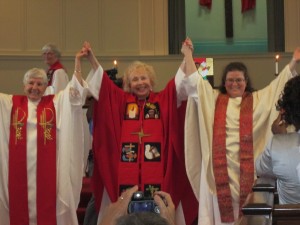 With the announcement today that Pope Francis has set up a commission to explore the possibility of women deacons, here are some thoughts on the matter.
With the announcement today that Pope Francis has set up a commission to explore the possibility of women deacons, here are some thoughts on the matter.
Throughout his pontificate the Pope has called for women to be granted more prominent roles in the church and for the Catholic church to continue to develop a positive “theology of women.” It emerges that Phyllis Zagano is one of the members of the commission. Unfortunately, Professor Zagano is not an objective participant. for a long time she has been a passionate advocate for the innovation of female deacons in the Catholic Church. One hopes that her biased position will be balanced by other members of the commission.
In a 2012 article arguing for the ordination of women to the diaconate, Zagano reported on a private conversation with then Cardinal Ratzinger. When asked about the possibility of women deacons he replied, “It is under study.” Are we right in pushing gently for women in the diaconate, or is it just as impossible as women’s ordination to the priesthood?
The question is clouded by the strong feelings on both sides of the issue of women’s ordination. At his website former priest John Wijngaards, an outspoken advocate for women priests, argues strongly for women to be ordained as deacons. Other progressive Catholic groups also push for the diaconate to be open to women, but it is their advocacy which makes conservative Catholics reluctant to even ask the question. They see that the Anglican Church first had deaconesses who then became deacons who were eventually ordained as priests and bishops. Conservatives contend that women deacons are the first step onto a slippery slope that leads to female bishops.
Putting the politics and passion aside, what are the historical arguments in favor of women deacons? The Scriptural evidence is interesting. Jesus chose men as his apostles, so women cannot be priests. However, it was the apostles who chose deacons in Acts chapter 6, so arguably the bishops, who are the successors of the apostles, could choose who they want as deacons. Although the apostles only chose men in Acts 6, in the epistle to the Romans St Paul mentions, “Phoebe, a deaconess in the church of Cenchreae.” St Jerome translates the word diaconos (deacon) as indicating that Phoebe was “in the ministry of the church”.
This leads us to ask what exactly the ministry of deaconess was in the early church. The best information is found in a collection of liturgical and disciplinary regulations called The Constitutions of the Holy Apostles. Most of the document dates from before the year 300, and we learn that, like the deacons, the deaconesses were involved in administering the charitable work of the church. They also had the job of maintaining modesty and decorum at baptisms. Since the convert was baptized naked, a woman was required to assist the female catechumens.
.In The Constitutions the Bishop is exhorted, “Ordain also a deaconess who is faithful and holy, for the ministrations towards women.” The bishop or priest was to “dip them in the water” and “…a deacon receive the man, and a deaconess the woman, that so the conferring of this inviolable seal may take place with a becoming decency” (Book III, Sections XV, XVI).
However, it should be observed that the role of deacon and deaconess were not interchangeable. For instance, the Apostolic Constitutions specify, “A deaconess does not bless, nor perform anything belonging to the office of presbyters or deacons, but only is to keep the doors, and to minister to the presbyters in the baptizing of women on account of decency” (Book VIII, Section XXVIII). While the bishop is to “ordain” deaconesses there is a significant difference between their ordination and that of the deacons.
The “ordination rite” for deaconesses recorded inThe Apostolic Constitutions references the holy women of the Old Testament and the Blessed Virgin and invokes the Holy Spirit to empower her for her work. The ordination prayer for deacons (unlike that of the prayer for the deaconesses) makes specific prayer for the deacon to be prepared for the “higher office” of the priesthood.
Therefore the evidence from the New Testament and the early church could provide arguments for women being ordained as deaconesses. As the order of permanent deacon was re-established in modern times, the order of deaconess could also be rejuvenated. Although canon law does not presently permit it, the law could be changed. Theoretically, the Catholic church could re-establish a distinct order of deaconess, and advocates would not be shy in pointing out the undoubted practical benefits from such a decision.
A full discussion, however, demands that we would have to question why such a change would be necessary. Continue Reading





